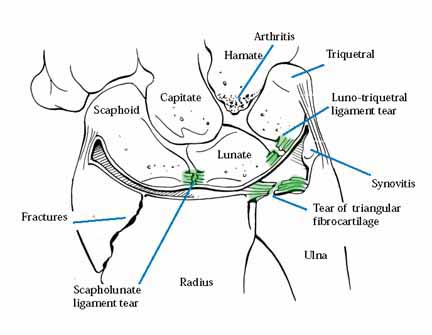Wrist Arthroscopy
Introduction
Wrist arthroscopy is an outpatient surgical procedure used to diagnose and treat problems inside the wrist. I will make small three or four incisions, usually less than a half-inch long, and insert a instrument called an arthroscope, which is smaller than the diameter of a pencil. The arthroscope contains a small lens, a miniature camera and a lighting system, enabling me to look directly inside the joint. Tiny probes, forceps, knives and shavers can then be inserted into the wrist and may be able to be used to correct some probems. I also have some nifty instruments for suturing inside the joint!
Wrist Anatomy
The wrist is a complex joint, with eight small bones and many connecting ligaments. Arthroscopy enables me to see the anatomic parts more easily than with an open incision. I can see the movement of the bones, test the tightness of the ligaments, look for cartilage damage, and make a more accurate diagnosis than I can from MRI or other imaging modalities (xray, arthrogram).

Arthroscopy
Diagnostic arthroscopy
Diagnostic arthroscopy may be used if the cause of your wrist pain cannot be identified or if wrist pain continues for several months despite nonsurgical treatment. Before surgery, I will perform:
-
A physical examination that focuses on your hand and wrist.
-
Provocative tests that involve moving your hand in ways that reproduce the pain.
-
Differential lidocaine injections, to help localize the source of the pain.
-
Imaging studies, such as X-rays of your hand and wrist.
Arthroscopic exploratory surgery may be used to confirm my diagnosis of a ligament tear or a triangular fibrocartilage (TFC) tear. Ligaments are fibrous bands of connective tissue that link bones, helping to control the motion of our joints and providing stability and support. The TFC is a fibrocartilaginous cushioning structure within the wrist, made of material very much like the intervertebral disk in your back. A fall on an outstretched hand can tear ligaments, the TFC or both, resulting in pain with movement or a clicking sensation. In some cases, after the diagnosis is made, the condition can be treated arthroscopically as well.
Arthroscopic Surgical Treatment
Several conditions can be treated using arthroscopic surgery, including tears in the ligaments or the triangular fibrocartilage complex (TFCC, which is the same as the TFC plus two extra ligaments). Often, there may be areas of inflammation, cartilage damage, or other findings after a wrist injury.
During arthroscopic surgery, the surgeon can trim or repair the tears. Wrist arthroscopy may also be used to smooth the bone surfaces and remove inflamed tissue.
Arthroscopic Surgery in General
Usually, general anesthesia is used during arthroscopic surgery. After the surgery, the incisions are each closed with a small stitch and a dressing is applied. Sometimes a splint may also be used.
After surgery, you will need to keep your wrist elevated for the first two or three days and keep your bandage clean and dry. You can ice your wrist to help keep swelling down. I will give you a prescription for specialized hand therapy. The hand therapist will teach you exercises to help maintain motion and rebuild your strength. Analgesic medications will help relieve any postoperative pain, which is usually mild. See my post-operative pain managment page.
Complications
Complications during or after arthroscopic wrist surgery are unusual, but may include infection, nerve injuries, excessive swelling or bleeding, scarring or tendon tearing. An experienced surgeon, particularly one who specializes in treating the hand, can reduce the likelihood of complications.
Summary
Arthroscopic surgery is a valuable diagnostic and therapeutic (treatment) tool. It is minimally invasive, and patients generally experience fewer problems and a more rapid recovery than with open surgery. Because it is an outpatient procedure, most patients are home several hours after surgery.
